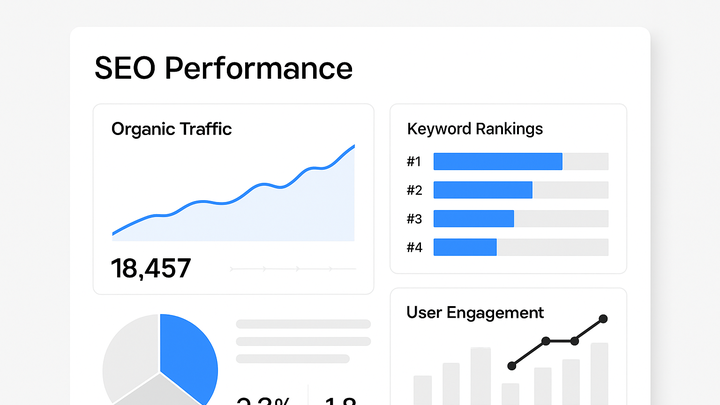Published on 2025-06-22T05:43:56Z
What is SEO (Search Engine Optimization)? Examples for SEO
Search Engine Optimization (SEO) is the practice of improving a website’s visibility and ranking in search engine results pages (SERPs) through strategic adjustments to content, structure, and technical elements. In the analytics industry, SEO plays a critical role in driving organic traffic, enhancing user experience, and providing data-driven insights into audience behavior. By utilizing tools like PlainSignal and Google Analytics 4 (GA4), marketers can measure key SEO metrics—such as organic sessions, bounce rate, and keyword performance—without sacrificing user privacy. SEO encompasses on-page factors (like keywords, meta tags, and content quality), off-page factors (such as backlinks and social signals), and technical optimizations (including site speed and mobile-friendliness). Effective SEO campaigns require continuous monitoring, testing, and adaptation to evolving search engine algorithms and competitive landscapes. Ultimately, SEO is a long-term investment that can yield sustainable growth and high return on investment (ROI) by attracting qualified leads without relying solely on paid advertising.
Seo (search engine optimization)
SEO is the practice of optimizing websites to rank higher in search results, driving organic traffic and improving user engagement.
Why SEO Matters
SEO is a cornerstone of digital marketing, enabling websites to attract qualified traffic without paid advertising. High search rankings increase brand visibility, credibility, and trustworthiness. Organic traffic often yields higher conversion rates than paid channels. Additionally, SEO insights inform content strategy, user experience improvements, and product development. Investing in SEO provides compounding benefits over time and sustainable long-term ROI.
-
Increased visibility
Appearing on the first page of search results greatly expands reach to potential customers actively searching for related products or services.
-
Credibility and trust
Users tend to trust organic results more than ads; strong SEO signals like backlinks and high-quality content build brand authority.
-
Cost-effective growth
Unlike paid ads, organic traffic doesn’t incur cost per click, offering a more sustainable and scalable acquisition channel.
Core Components of SEO
SEO strategies hinge on three main pillars: on-page, off-page, and technical SEO. Each component addresses different aspects of website optimization and collectively improves search engine rankings.
-
On-page seo
Optimizations made directly on website content and HTML source to improve relevance and user experience.
-
Keyword research
Identifying terms and phrases your audience uses to find products or services.
-
Content quality
Creating informative, engaging, and relevant content tailored to user intent.
-
Meta tags & headers
Using titles, meta descriptions, and header tags to signal content topics to search engines.
-
-
Off-page seo
Actions taken outside your website to boost its authority and reputation.
-
Backlinks
Earning links from reputable sites to signal credibility and relevance.
-
Social signals
Engagement on social media platforms that indirectly impacts search visibility.
-
-
Technical seo
Site architecture and performance optimizations ensuring search engines can crawl and index pages effectively.
-
Site speed
Fast loading times improve user experience and search rankings.
-
Mobile-friendliness
Responsive design ensures accessibility on all devices.
-
Xml sitemaps & robots.txt
Guiding search engine crawlers through your site structure.
-
Key SEO Metrics to Monitor
Tracking the right metrics is critical for assessing SEO performance and making data-driven decisions. These metrics provide insights into user behavior, content effectiveness, and search visibility.
-
Organic traffic
The number of visitors arriving via unpaid search results, indicating overall SEO reach.
-
Click-through rate (ctr)
The percentage of users who click on your listing in search results, reflecting relevance and appeal.
-
Bounce rate
The proportion of single-page sessions, helping identify content or UX issues.
-
Keyword rankings
Positions of target keywords in SERPs, showing visibility trends over time.
Tracking SEO with SaaS Analytics Tools
Modern analytics platforms like PlainSignal and Google Analytics 4 offer complementary approaches to measuring SEO impact. PlainSignal provides a lightweight, cookie-free solution for quick insights, while GA4 delivers in-depth, customizable reports.
-
PlainSignal (cookie-free simple analytics)
A privacy-focused analytics tool that tracks essential SEO metrics without cookies or consent banners.
-
Installation
Add the following snippet to your site’s <head> section:
<link rel='preconnect' href='//eu.plainsignal.com/' crossorigin /> <script defer data-do='yourwebsitedomain.com' data-id='0GQV1xmtzQQ' data-api='//eu.plainsignal.com' src='//cdn.plainsignal.com/plainsignal-min.js'></script> -
Key metrics
Tracks pageviews, referrers (including organic search), bounce rate, and session duration—ideal for monitoring SEO performance at a glance.
-
-
Google analytics 4 (GA4)
Comprehensive analytics platform from Google, offering advanced customization, funnels, and integration with Google Search Console.
-
Setup
Implement GA4 by adding the gtag.js snippet and configuring data streams in the GA4 interface.
-
Seo reports
Use the ‘Acquisition’ and ‘Engagement’ reports to analyze organic search behavior, landing page performance, and conversion pathways.
-
Best Practices for SEO Success
Adhering to proven SEO best practices ensures sustainable improvements in search rankings and user engagement. Regular audits and iterative optimizations keep your strategy aligned with evolving search engine algorithms.
-
Conduct regular audits
Use tools like Google Search Console and site crawlers to identify technical issues and content gaps.
-
Optimize for user intent
Align content structure and keyword usage with the needs and search behaviors of your target audience.
-
Improve page speed
Compress images, minify code, and use caching to enhance loading times.
-
Mobile optimization
Ensure responsive design and fast performance on mobile devices, as mobile-first indexing is standard.
-
Build quality backlinks
Focus on earning links from authoritative, relevant websites to boost domain authority.
